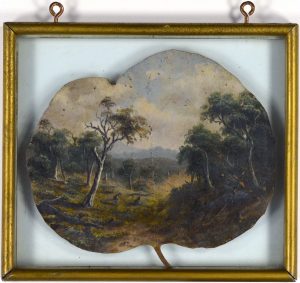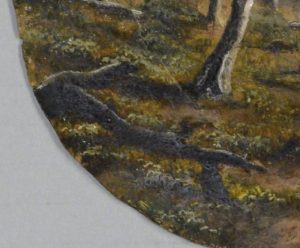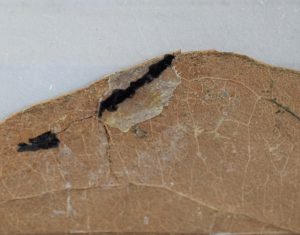Can You Be-Leaf It?
by Hannah Stewart

Embarking on a major treatment is full of excitement and trepidation, especially when working on a painting with such a very unusual support!
My major treatment project is a leaf painted by Alfred William Eustace (c 1870s) belonging to the Grainger Museum. Eustace emigrated to Chiltern in North Eastern Victoria in 1851 and began painting to capture the spirit of the Australian bush. Canvas and paper were not often readily available on the goldfields, so Eustace turned to large juvenile white box gum leaves. It is not unheard of for artists to paint on leaves, but while that was often a departure from the norm.

While the unusual use of a leaf as a substrate (the material on which paint is applied e.g. canvas, paper) means this is a wonderfully unique piece of art, it also poses many challenges in terms of conservation. Conservation literature covers the care for paintings on canvas thoroughly but there is nowhere near as much information available about using paintings conservation techniques on a plant based substrate. This means that traditional treatments for oil paintings may not work – as introducing too much water could cause the leaf to swell and change (and risk the leaf curling!), and using solvents is risky without understanding the effect that they will have on the plant matter, as they could make the delicate leaf more brittle.
The leaf is in fairly stable condition, as it has been kept flat and is somewhat protected from environmental hazards by its glass frame. As seen in Fig. 2, there are two repairs to splits of the leaf; sticky tape holds together a small split, while a fabric mend has been used for the larger split. The paint layer is in good condition as there is little flaking or cracks apart from near the splits. A white substance sits on the surface of the oil paint in a couple of areas (see Fig. 3), which is possibly the migration of components of the paint layer to the surface due to exposure to changes in temperature and relative humidity.


The main goal in this treatment is to keep the leaf in as stable a condition as possible in order to ensure its longevity. The cracks in the leaf itself pose the most immediate threat, as these can easily become bigger through handling of the leaf, or they can lead to flaking in the paint around the crack. The next problem to resolve is removal of the white substance (often called blooming or efflorescence) across the paint layer. The last goal is to re-work the frame to provide better protection for the leaf from environmental fluctuations, and prevent further fogging on the glass (see Fig. 4).
Treatment Blog 2: To Tear (Repair) or not to Tear (Repair)
A major issue for conservation of the Eustace Leaf is addressing the two tears and assessing their current repairs.

The decision was made to remove the current repairs. Sticky tape has the potential to cause further damage to the leaf due to the unknown reaction of its adhesive with the leaf. Chemicals in the adhesive can cause damage, and the tape can cause stress on the support – as it is stronger than the leaf it is holding together. The fabric patches, while very neatly applied, are thick and very stiff. A more flexible material is needed so that the stiffness of the repair does not put too much pressure on the leaf, potentially worsening the splits. A thinner repair will also be undertaken, removing the pressure from surrounding areas of the fabric repair which are not supported.
The first step in stabilising the splits is to remove the current mends. The sticky tape was removed mechanically (i.e. by hand without the use of chemicals or water). A very small scalpel and very small tweezers were used to slowly lift the tape and break the bonds of the adhesive underneath. This was undertaken under magnification, to ensure there was no damage to the rest of the leaf. Some weight was then placed on the leaf and the tape gently rolled off to cause as little vibration as possible.

While the fabric mend is a much better technique than the sticky tape, the fabric is thick and double layered – causing stress on other parts of the leaf that can’t lie flat. The fabric is also so heavily impregnated with adhesive that it is hard and stiff. Attempts were made to pry away strands from the edges of the fabric and remove the mend that way. Unfortunately, this didn’t work given the amount of adhesive. Instead, small patches of damp blotting paper were placed on the fabric and covered with plastic. This created a small humidification chamber, where the water vapour broke down the bonds of the adhesive, without directly applying water onto the leaf itself. After a few rounds of humidification, the two pieces of fabric easily pried away from the leaf.
A Japanese paper tear repair was undertaken, as Japanese tissue paper is flexible, free from impurities, and has long fibres. Starch paste is used to adhere the Japanese paper tissue as it strong, will not discolour, and is easily reversible. Small pieces of the tissue are frayed at the ends so there are long fibres to grip to the leaf, and are then painted with starch paste and delicately placed into position. Starch paste is applied to the paper rather than the object, as the blotting paper used to hold the tissue absorbs extra water, reducing the amount of moisture in contact with the object. After application, the tissue repairs are weighted down, and when dried are solid and secure (see Fig. 3).

Treatment Blog 3: Treatment Re-Leaf
Investigation of the white haze across the paint film revealed it to likely be fatty acids migrating from the paint layer. The removal of this discolouration and the creation of a new micro-climate frame to prevent its recurrence is the other major focus of this treatment.
Efflorescence, also sometimes referred to as bloom or blanching, refers to the hazy white layer that can develop over paint films. This haze is actually a network of tiny, clear crystals sitting on the surface of the paint layer. This is due to the migration of free fatty acids from the paint film itself to the surface. The fatty acids are produced within the paint film and are likely due to the components used in creating the paint, such as its binder. Pigment use also plays a role, as efflorescence is generally found in darker pigmented areas. This was the case with the Eustace Leaf. The dark browns used to paint logs are the most severely effected, while there was only little evidence of the migration in the pale areas.
Removal of these crystals can done mechanically. Small areas were cleared of the efflorescence in this way, but is time-intensive and not feasible for treating the entire leaf. Conservation literature recommended the use of white spirits to remove the bloom, and this was attempted with successful results. The solvent was applied with a cotton swab. A dry swab was then rolled over the area to collect excess solvent and to pick up the minuscule crystals. Figure 1 shows the success of this treatment.

The frame that the Eustace Leaf was originally displayed in sandwiched the object between two pieces of glass, allowing the front (recto) and back (verso) of the leaf to be visible. While this was great for viewing such an unusual object, the frame was not well sealed, meaning dust and dirt could make its way to the leaf. In addition, the glass was pressing against the leaf itself, which can burnish the paint surface and put unnecessary pressure on the leaf.
The decision was made to mount the Eustace Leaf before framing. This means the neat visual of both side of the leaf is gone, but the leaf will be much more stable. Other leaves painted by Alfred William Eustace are mounted and framed, so this will be in keeping with the rest of his works, but to compensate, a high resolution image of the verso will be attached to the back of the frame.

A micro climate frame is one that seals the artwork into the frame completely, protecting the object from environmental fluctuations and from dust and dirt. Figure 2 shows how the frame will be constructed. Mount board will be used as a spacer – lifting the glass off the leaf. The leaf will be attached to its backing board using Japanese tissue paper hinges, which are very similar to the tear repairs discussed above. All of this is wrapped in Marvelseal, a heat sealable barrier material which prevents the transmission of oxygen and moisture. This framing system will hopefully protect the Eustace leaf from environmental fluctuations, keeping it in a good condition for the future.
Acknowledgements
I would like to thank Dr. Nicole Tse and Libby Melzer for providing support and advice on treatment decisions, particularly with relation to tear repairs and microclimate framing. I would also like to thank The Grainger Museum for allowing me to work on such an interesting item.